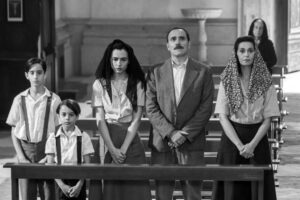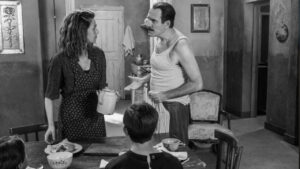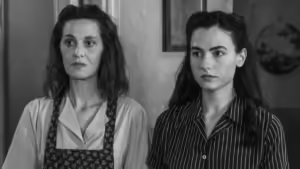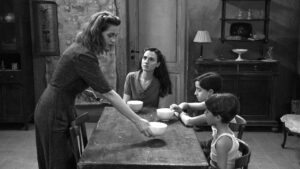A brief review of the film C’è ancora domani (2023)
If there’s any film you should not read any review of prior to seeing, it is the first directorship by actress Paola Cortellesi C’è ancora domani (There is still tomorrow). It was a box-office success in Italy in 2023, beating even Barbie, which, we note, benefited from the usual massive publicity campaign that standard-issue films are given in the USA. Many people will tell you about domani’s core message inadvertently. But, as I said, if you haven’t seen it, do not read any reviews. And if someone starts breathlessly telling you about it, promise you’ll see it, but only if they can keep their recitative to themselves.

The ending is only surprising and worth discovering because of the rest of the movie, the build-up, the distractions… Cortellesi, who co-wrote the script, has created a fairytale of sorts that moves along by many small shocks — there is a hint of Cinderella, but only a hint. Throughout, Cortellesi drops breadcrumbs that misdirect the viewer, leading into sidelines that are more or less relevant to the story. But they provide a rich diet of emotional and visual food thanks to a very voyeuristic camera that draws attention to a life “caught in the act” (to reference Siegfried Kracauer) rather than to itself. There is very little high-tech stuff to wow the geeks, few gimmicks, and those that are present pertain to the story. Hardly noticeable is the change in aspect ration from 4:3 inside (tight, oppressive) and 16:9 outside (freedom, airy).
It begins with the choice of back and white film, which immediately throws us back not only to the time the film plays in (1946, Rome) but also to those despair-ridden, gritty, at times tragicomic neorealist films of postwar Italy by Vittorio de Sica (Ladri di biciclette, or Bicycle Thieves), Fellini (La Strada), Lucchino Visconti (who pre-launched the movement with Ossessione in 1943, and went on to make Terra trema).

The period reminder and general theme is laid out within inches of the film’s beginning: traditional patriarchal violence against women. Sounds almost hackneyed these days, and yet it is pertinent, especially considering the rise in cosplayed alpha-male-ism … (I can hear the ghost of Limbaugh complaining about “feminazis.”). What is particularly troubling in this first scene, is not only the morning slap Ivano delivers routinely to his wife Delia’s face. It’s her total overt acceptance of pain and humiliation, followed by how she goes about her day.


And what a day it is! Springtime has arrived, and that means a fresh start in the year. We see her odd jobs, all slightly absurd, like giving injections, making umbrellas, delivering lingerie. We witness her small joys, like meeting a generous friend while shopping, who, in contrast to her, has a husband who is docile. And we encounter banal injustices that she accepts, because it’s as normal as breathing. And there is the interaction with the children, especially with her teenage daughter Marcella.
There are more beatings, directed in a way that maintains the very steady rhythm of the film by choreographing them in small bubbles of sorts, with a contrasting musical score, or by having us, the audience, move to another space along with Marcella, where we become spectators in the storyline itself. They occur without any exaggerated sounds of hands-on flesh, without any gory and distracting make-up, they are presented, as a weird, ghastly ritualistic dance, almost – and this is important – like the first dance at a wedding.

Violence against women, which is still an enormous problem in our societies, is the backdrop throughout, and it is so accepted in the story that it even has an audience. The ritual is understood and apparently accepted by most characters, even reluctantly by Delia’s daughter Marcella, whose destiny as a successor to her mother seems sealed, because though she wants to study, she can’t. Women are mere child-bearing, household-caring creatures in that society.
Throughout, Cortellesi, who plays the beautiful but deadpan weary Delia, drops subtle and not so subtle hints of the situation. She looks after the family in spite of wrenching poverty, does her best, and is constantly reminded by her husband to shut up. She’s even spoken of in the third person when she is present. And of course, each “error” on her part is punished.

Dutifully, too, as in myriad cases of violence against women, the victims will tend to make excuses…. For Delia, it’s “He’s been through two wars.” She’s heard it a thousand times before. She doesn’t believe it, but at least on the surface, it helps here survive.
But it’s not all dreary and dull and unfair. We, the audience, trained in stories, trained in fairy-tales, know that something must happen, otherwise this movie would not exist… What will break the cycle of violence? What is going to change in that spring of 1946? What will trigger Delia/Cinderella to change the trajectory of her life? We know it must happen, because this is a story with a beginning, a middle, and an end.
There are those breadcrumbs that Cortellesi, who cowrote the script with Furio Andreotti and Giola Calenda, drops, that make us curious and even raise our expectations, our romantic being, our deep need for some sort of revenge. Why does she hide a part of her meager earnings? What is that letter she gets? What’s up with the Black American MP? Is he just a reminder that this is Rome in after the war? Then, there’s the former lover… Many lines of breadcrumbs, all contributing nourishment to the eye and soul, but only one really leads to the end.
Conclusion
I would love to reveal it, but all the droll, absurd, tragic, elements are just building blocks of this outstanding movie. The subplots and sub-side-plots are vignettes that of course play on our emotions, build our expectations, and create the kind of suspense movies live on. The tension release does come, and because our 21st-century expectations are different, especially if we are trained in the typical “Hollywood wrap-up,” it comes as a surprise.
Enough said.. You have to see the C’é ancora domani to find out, and we can chat about my criticisms – and I have a few. For the moment, however, my pen and keyboard are sealed….








